List 7
1.Echinacea purpurea
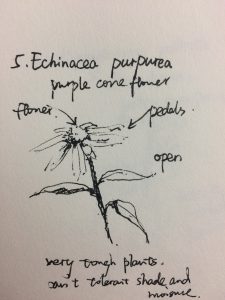
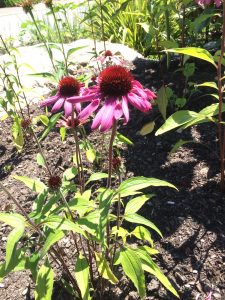
Common name: purple coneflower
family name: Asteraceae
USDA Hardiness Zone: 3-8
Mature height and spread:
height: 2-5feet
spread: 1.5-2feet
Form:coarse, rough-hairy
Water use: medium
Soil requirements: dry to medium, well-drained soil
Flower/Cone/Fruit description:Echinacea purpurea, commonly called purple coneflower, is a coarse, rough-hairy, herbaceous perennial that is native to moist prairies, meadows and open woods of the central to southeastern United States (Ohio to Michigan to Iowa south to Louisiana and Georgia). It typically grows to 2-4′ tall. Showy, daisy-like, purple coneflowers (to 5″ diameter) bloom throughout the summer atop stiff stems clad with coarse, ovate to broad-lanceolate, dark green leaves.
Limitations:Japanese beetle and leaf spot are occasional problems.
suitable uses:Excellent, long-blooming flower for massing in the border, meadow, native plant garden, naturalized area, wildflower garden or part shade area of woodland garden. Often massed with black-eyed Susans.
2.Gaillardia aristata
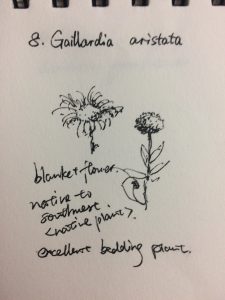
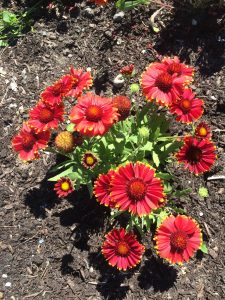
Common name: blanket flower
family name: Asteraceae
USDA Hardiness Zone: 3-10
Mature height and spread:
height: 8-10 inches
spread: 10 inches
Form:slightly branched
Water use: medium
Soil requirements: dry to medium, well-drained soil
Flower/Cone/Fruit description:
Leaves:
Basal leaves (if present) entire to coarsely toothed or pinnately cut; stem leaves alternate (or lacking in dwarfed plants), entire to pinnately cut, linear-oblong or the lower oblanceolate, up to 15 cm long and 2.5 cm wide, hairy.
Flowers:
Heads with ray and disk flowers, solitary or few on long stalks; involucres 8-20 mm tall; involucral bracts several, overlapping, loosely hairy and spreading, with long-pointed tips; receptacles with well-developed scales which exceed the achenes; ray flowers yellow, often with purple bases, 6-16, commonly 13, 1-3.5 cm long, tips broad and 3-lobed; disk flowers brownish-purple, rarely yellow, woolly-hairy at the top.
Fruits:
Achenes 3-4 mm long, faintly ribbed, densely hairy; pappus of 6-10 long-pointed, white scales.
suitable uses:Container/Patio, Prairie, Cottage, Eclectic
3.Kirengeshoma palmata
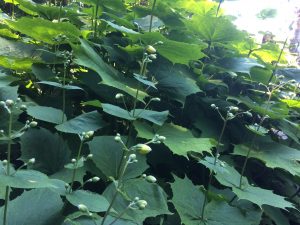
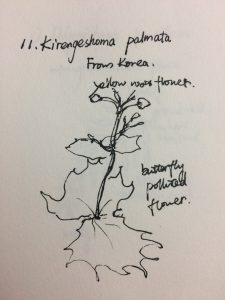
Common name: yellow wax bells
family name: Hydrangeaceae
USDA Hardiness Zone: 5-8
Mature height and spread:
height: 3-4feet
spread: 2-3feet
Form:shrubby, herbaceous perennial
Water use: medium
Soil requirements: dry to medium, well-drained soil
Flower/Cone/Fruit description:A somewhat shrubby, herbaceous perennial with erect, purplish stems typically growing 3-4.5′ tall. Features coarsely toothed, deeply lobed, maple-like leaves (to 8″ across) which are perhaps the most outstanding feature of the plant. Narrow, drooping, waxy, bell-shaped yellow flowers (1.5″ long) appear in both terminal and upper leaf axillary clusters (cymes), usually three flowers per cluster, from late summer to early autumn. Flowers give way to somewhat grotesquely interesting, three-horned, brownish-green seed capsules.
Limitations:Japanese beetle and leaf spot are occasional problems.
suitable uses:Unique and interesting plant for the shaded border or woodland garden.
4.Paris polyphylla
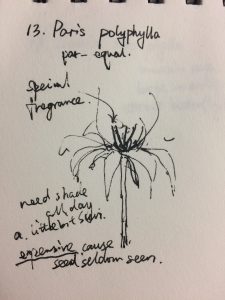
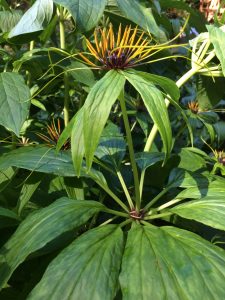
Common name: paris
family name: Melanthiaceae
USDA Hardiness Zone: 7-10
Mature height and spread:
height: 3feet
spread: 1feet
Form:up-right bushy
Water use: medium
Soil requirements: dry to medium, well-drained soil
Flower/Cone/Fruit description:Paris polyphylla is a Trillium relative with green-and-black flowers highlighted by long, wild yellow anthers.
Blooms are 6 inches across, measuring from the lower petals, which are the 5 symmetrical green stems that look like leaves. The central stigma is a red so deep it might as well be black, surrounded by a short golden ray and long, slender, whisker-like yellow anthers.
suitable uses: private garden area
List 8
1.Alcea rosea
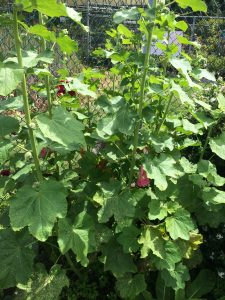
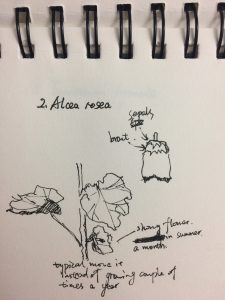
Common name: hollyhock
family name: Malvaceae
USDA Hardiness Zone: 2-10
Mature height and spread:
height: 6-8feet
spread: 1-2feet
Form:up-straight
Water use: medium moisture
Soil requirements: well-drained soil in full sun
Flower/Cone/Fruit description: The flowers grow on rigid, towering spikes or spires which typically reach a height of 5-8′ tall and usually do not require staking. Foliage features large, heart-shaped (3, 5 or 7 lobes), rough lower leaves which become progressively smaller toward the top of the spire. Long bloom period of June to August. Sometimes listed in nursery catalogs under Althaea.
Limitations:Foliage is susceptible to rust, leaf spot and anthracnose. Spider mites and Japanese beetle can also be problems. Foliage can become rather tattered and unkempt in appearance when attacked by the aforementioned insects and/or diseases, but the flowers generally are not affected. May need staking, particularly if not protected from wind.
suitable uses:Hollyhocks provide excellent architectural height, contrast and a certain amount of old world charm to cottage gardens and border backgrounds. Also effective when grown against walls or fences.
2.Lythrum salicaria
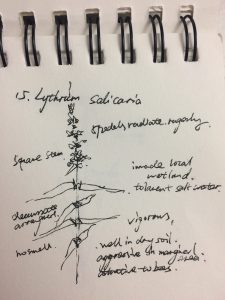
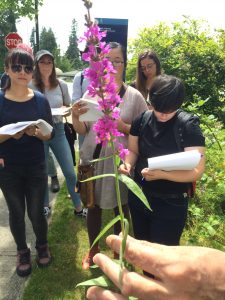
Common name: purple loosestrife
family name: Lythraceae
USDA Hardiness Zone: 4-9
Mature height and spread:
height: 2-4feet
spread: 2-4feet
Form:clump-forming wetland perennial
Water use: medium moisture
Soil requirements: well-drained soil in full sun
Flower/Cone/Fruit description: In full flower, a colony of purple loosestrife produces spectacular bloom. The problem is that it is so invasive that it can rapidly colonize wet areas and both choke out native vegetation and destroy wildlife habitat. It typically grows 2-4’ tall on stiff upright stems. Downy, stemless, lance-shaped leaves (to 4” long) are opposite or sometimes in whorls of three. Magenta flowers appear in dense terminal spikes (to 18” long) over a long summer to early fall bloom period.
Limitations:Species plants are very invasive and should not be planted. Japanese beetles may attack the foliage and/or flowers. Susceptible to slugs and snails.
suitable uses:Notwithstanding serious concerns over invasiveness, these plants grow exceedingly well in bog gardens, along bodies of water or in low spots. They have the potential to prolifically self-seed. If purple loosestrife must be planted in areas where it is legal to do so, sterile cultivars should be used.
3.Typha latifolia
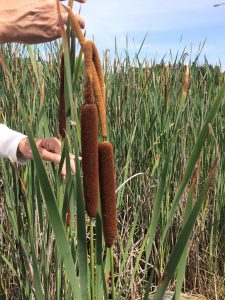
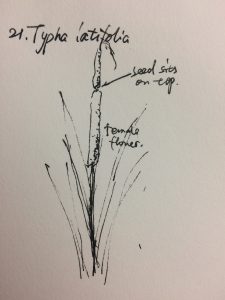
Common name: cattail
family name: Typhaceae
USDA Hardiness Zone: 3-10
Mature height and spread:
height: 4-6feet
spread: 4-6feet
Form: narrow, upright, sword-like, linear
Water use:native to marshes, swamps and wetlands
Soil requirements: well-drained soil in full sun
Flower/Cone/Fruit description: Features narrow, upright, sword-like, linear, mostly basal, green leaves (to 7’ long) and a stiff, unbranched central flower stalk that typically rises equal to or slightly less than the height of the leaves (usually around 6’ tall but infrequently to as much as 10’). Plants are monoecious, with each flower stalk being topped by two sets of minute flowers densely packed into a cylindrical inflorescence. Yellowish male (staminate) flowers are located at the top of the inflorescence and greenish female (pistillate) flowers are located underneath. In this species, the staminate and pistillate flowers are not separated by a gap. Flowers bloom in summer. After bloom, the male flowers rapidly disperse, leaving a naked stalk tip. The pollinated female flowers turn brown as the seeds mature, forming the familiar cylindrical, sausage-like, cattail fruiting spike
Limitations:Aggressive spreader outside of containers.
suitable uses:Water gardens, ponds.
4.Yucca filamentosa ‘Golden Sword’
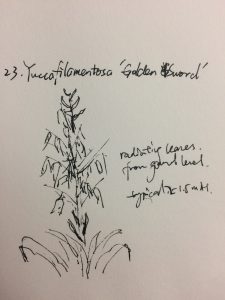
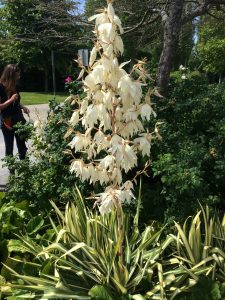
Common name: Golden Sword yucca
family name: Asparagaceae
USDA Hardiness Zone: 5-10
Mature height and spread:
height: 4-8feet
spread: 2-3feet
Form: virtually stemless broadleaf evergreen shrub
Water use:native to marshes, swamps and wetlands
Soil requirements:dry to medium, well-drained soils
Flower/Cone/Fruit description: It features a basal rosette of rigid, sword-shaped, spine-tipped green leaves (to 30” long and to 4” wide) with long filamentous (as per specific epithet) curly threads along the margins. Leaves form a foliage clump to 2-3’ tall. In late spring, a flowering stalk rises from the center of each rosette, typically to 5-8’ tall, but infrequently to 12’ tall, bearing a long terminal panicles of nodding bell-shaped creamy white flowers. Fruits are elliptical dehiscent capsules.
suitable uses:Borders. Dry garden areas. Dry slopes. Adds architectural height. Interest in yuccas for the home garden has been somewhat tempered in recent years by a proliferation of commercial plantings in such areas as parking lots of fast-food restaurants.